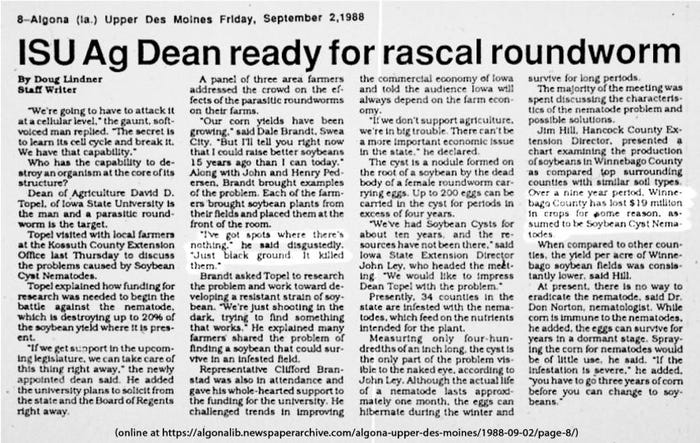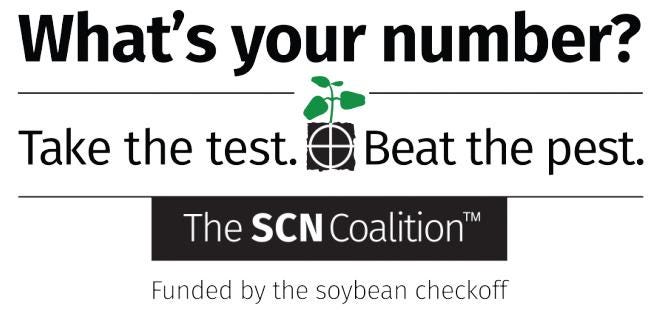September 11, 2018

Source: Iowa State University
By Greg Tylka
I recently moved offices for the first time since arriving at Iowa State University in February 1990. While moving, I uncovered several things that I had not seen in many years. One of those items was a faded news article that a colleague sent me written by Doug Lindner in the Algona Upper Des Moines newspaper originally published on September 2, 1988 (see figure below, article is available online here).
The article described a visit to north central Iowa in 1988 by newly appointed Dean of the ISU College of Agriculture David Topel. He traveled to speak with farmers, legislators, and agribusiness and extension personnel about an emerging threat to soybean production in Iowa - the soybean cyst nematode (SCN).

SCN in Iowa - a retrospective
Reading the news article from 1988 again made me reflect on the SCN situation in Iowa over the past several decades. Looking back, some things that stand out to me include:
SCN spread from a single county in Iowa (Winnebago County) in 1978, to 34 counties in 1988, to all 99 Iowa counties in 2016. Also, SCN currently is found in every soybean-producing state in the United States except West Virginia.
SCN consistently has been identified as the most damaging pathogen of soybeans in Iowa and in the United States since the mid 1990s.
The number of SCN-resistant soybean varieties for Iowa has increased from about 20 in the early 1990s to more than 1,000 in 2017.
Nematode-protectant seed treatments were introduced as a much-needed new tool for managing SCN in the last decade.
Perceptions about SCN in Iowa have changed over the decades - from grave concern over severe damage in the 1980s (see figure above), to a unified call for testing of fields for SCN in the 1990s (“Take the Test, Beat the Pest” - The SCN Coalition), to effective management of SCN in the 2000s. What about now?
SCN in Iowa - now and in the future
Managing SCN used to be pretty routine. Once a field was found to be infested with SCN, a farmer simply had to grow resistant soybean varieties in rotation with corn in that field. And there were hundreds of SCN-resistant soybean varieties for Iowa available by the end of the 1990s. Currently, few soybean varieties are described as being not resistant (i.e. susceptible) to SCN.
Almost all SCN-resistant soybean varieties since the early 1990s were developed from the same soybean breeding line, or “source of resistance”, named PI 88788. These resistant varieties controlled most (> 90%) SCN reproduction for many years. But researchers from several states who were monitoring the reproduction of SCN populations on resistant soybean varieties detected a troubling trend over the years – SCN populations were becoming resistant to the resistance.
Currently, SCN populations that reproduce well on resistant soybean varieties with the PI 88788 source of resistance are common and widespread throughout Iowa and the Midwest.
Put simply: soybean varieties with PI 88788 SCN resistance no longer control SCN well in many (most?) fields in Iowa and in several other states. Also, farmers are losing yield as a result of increased SCN reproduction on resistant soybean varieties.
So, what’s a farmer (or agronomist) to do?
Managing SCN for the long term requires active effort like never before. The SCN Coalition from the 1990s has re-formed now to emphasize this situation. Recommendations from the SCN Coalition are:
Collect soil samples from fields before every second or third soybean crop to monitor changes in SCN population densities (numbers) over time.
Use a broad-based, multi-faceted approach to manage SCN. Available management strategies include SCN-resistant varieties, nonhost crops (like corn), and nematode-protectant seed treatments.
Seek out and grow SCN-resistant soybean varieties with sources of resistance other than PI 88788. Currently, “Peking” is the most common non-PI 88788 source of SCN resistance available.

Go to www.TheSCNCoalition.com for more information about the SCN Coalition, including a timeline of SCN history, data illustrating the gradual buildup of resistance-breaking populations of SCN and associated yield losses, lists of SCN experts and soil-processing laboratories in every state in the United States and in Canadian provinces, and state-specific SCN management recommendations. The SCN Coalition is funded by the soybean checkoff through the North Central Soybean Research Program and the United Soybean Board and by industry partners.
You May Also Like




